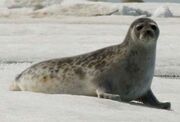| ||||||||||||||
The bodach (Gaelic: "old man") or lesser seal was a cryptid pinniped reported historically from the Atlantic Ocean around the Hebrides of the United Kingdom,[3] particularly the Isle of Colonsay, usually believed to have represented a colony of the small Arctic ringed seal (Pusa hispida).[2][4]
Attestations[]
Information on the bodach was first communicated to naturalist James Wilson by Archibald M'Neill of the Isle of Colonsay, who had seen these seals several times during the 1830s, initially believing them to be juvenile harbour seals (Phoca vitulina), despite local belief that they were distinct. N'Neill came to accept that these small seals were fully-grown after seeing bodach specimens, the size of three-month-old harbour seal calves, which bore decayed teeth. According to M'Neill, the bodach was uncommon, but not particularly rare.[1] The Hebridean naturalist Graham Henry Davenport also collected accounts of the bodach from Colonsay during the 1860s, finding that it was well-known to local people.[5]
Description[]
The bodach was significantly smaller than the harbour seal, around the size of a three-month-old calf, but its appearance was not otherwise described. According to M'Neill, it was solitary, but not shy, and generally kept away from harbour seal colonies.[1] However, Davenport claimed that the bodach was known to "consort" with ordinary seals.[5]
Theories[]

The bodach may have been a Hebridean population of the ringed seal (Pusa hispida) (Public Domain).
Only two seals are common in the Hebrides: the harbour seal (Phoca vitulina) and the grey seal (Halichoerus grypus), although the large bearded seal (Erignathus barbatus) was also formerly reported to exist there. James Wilson believed that the bodach could have been an undescribed third seal species.[1] Most later 19th Century naturalists who examined the question concluded that it was likely a Hebridean colony of the ringed seal (Pusa hispida), an Arctic species which occasionally wanders to the British Isles. Ringed seals are the smallest Arctic seals, not generally exceeding around 5 ft (1.5 m) in length.[2][4] However, by the beginning of the 20th Century, the term bodach was used in the Hebrides to refer to adult male specimens of the common seal.[6]
Notes and references[]
- ↑ 1.0 1.1 1.2 1.3 1.4 Wilson, James "Notes Regarding the Distinctive Habits of the Scotch Phocæ or Seals," Magazine of Zoology and Botany, Vol. 1 (1837)
- ↑ 2.0 2.1 2.2 Brown, Robert "Notes on the History and Geographical Relations of the Pinnipedia Frequenting the Spitzbergen and Greenland Seas," Proceedings of the Zoological Society of London (1868)
- ↑ Arment, Chad (2004) Cryptozoology: Science & Speculation, Coachwhip Publications, ISBN 978-1930585157
- ↑ 4.0 4.1 Watson, John (1889) Sylvan Folk: Sketches of Bird and Animal Life in Britain
- ↑ 5.0 5.1 Graham, Henry Davenport (1890) The Birds of Ioana and Mull
- ↑ Millais, John Guille (1904) The Mammals of Great Britain and Ireland
